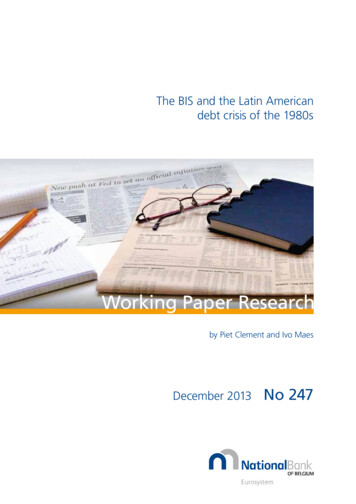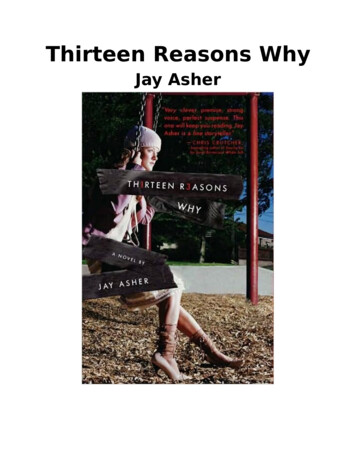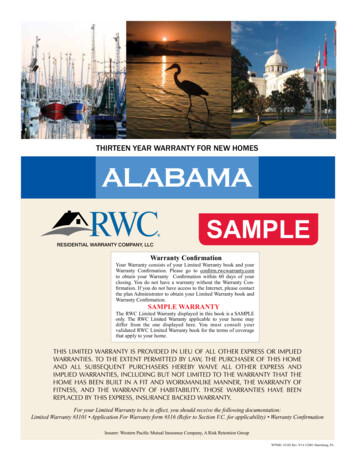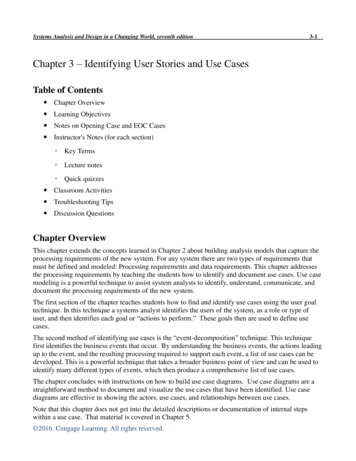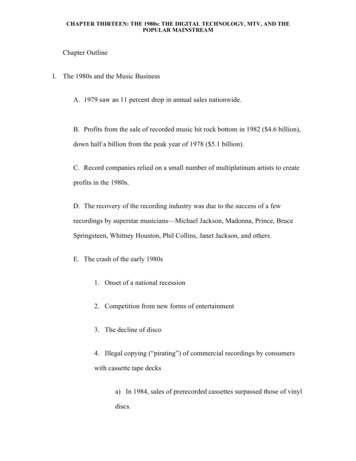
Transcription
CHAPTER THIRTEEN: THE 1980s: THE DIGITAL TECHNOLOGY, MTV, AND THEPOPULAR MAINSTREAMChapter OutlineI. The 1980s and the Music BusinessA. 1979 saw an 11 percent drop in annual sales nationwide.B. Profits from the sale of recorded music hit rock bottom in 1982 ( 4.6 billion),down half a billion from the peak year of 1978 ( 5.1 billion).C. Record companies relied on a small number of multiplatinum artists to createprofits in the 1980s.D. The recovery of the recording industry was due to the success of a fewrecordings by superstar musicians—Michael Jackson, Madonna, Prince, BruceSpringsteen, Whitney Houston, Phil Collins, Janet Jackson, and others.E. The crash of the early 1980s1. Onset of a national recession2. Competition from new forms of entertainment3. The decline of disco4. Illegal copying (“pirating”) of commercial recordings by consumerswith cassette tape decksa) In 1984, sales of prerecorded cassettes surpassed those of vinyldiscs.
CHAPTER THIRTEEN: THE 1980s: THE DIGITAL TECHNOLOGY, MTV, AND THEPOPULAR MAINSTREAMF. New technologies of the 1980s1. Digital sound recording and five-inch compact discs (CDs)2. The first CDs went on sale in 1983, and by 1988, sales of CDssurpassed those of vinyl discs.3. New devices for producing and manipulating sound:a) Drum machinesb) Sequencersc) Samplersd) MIDI (Musical Instrument Digital Interface)G. Music Television (MTV)1. Began broadcasting in 19812. Changed the way the music industry operated, rapidly becoming thepreferred method for launching a new act or promoting a superstar’s latestrelease.3. The first song broadcast on MTV was “Video Killed the Radio Star.”4. MTV—and its spin-off VH-1, aimed at an older, twenty-five- to thirtyfive-year-old audience—worked synergistically with radio and othermedia to boost record sales and create a new generation of rock superstars.
CHAPTER THIRTEEN: THE 1980s: THE DIGITAL TECHNOLOGY, MTV, AND THEPOPULAR MAINSTREAM5. It also strongly influenced the direction of popular music in the early1980s, sparking what has been called a second British Invasion.a) Promoted English artists such as Eurythmics, Flock ofSeagulls, Adam Ant, Billy Idol, and Thomas Dolbyb) In July 1983, eighteen of the singles in Billboard’s Top 40chart were by English artists, topping the previous record offourteen, set in 1965 during the first British Invasion.6.By the mid-1980s, the impact of MTV had been felt throughout themusic industry.7. MTV’s focus on white rock artists reminded many critics of theexclusionary practices of album-oriented rock radio in the 1970s.a) Out of more than 750 videos shown on MTV during thechannel’s first eighteen months, only about twenty featured blackmusicians (a figure that includes racially mixed bands).b) At a time when black artists such as Michael Jackson and RickJames were making multiplatinum LPs, they could not break intoMTV, which put Phil Collins’s cover version of the Supremes’“You Can’t Hurry Love” into heavy rotation but played no videosby Motown artists themselves.
CHAPTER THIRTEEN: THE 1980s: THE DIGITAL TECHNOLOGY, MTV, AND THEPOPULAR MAINSTREAMc) Executives at MTV responded to widespread criticism of theirpolicy with the argument that their format focused on rock, a styleplayed by few black artists.8. The mammoth success of Michael Jackson’s Thriller, released byColumbia Records in 1982, forced a change in MTV’s essentially allwhite rock music format.a) The videos made to promote the Thriller LP through three ofits hit singles—“Billie Jean,” “Beat It,” and “Thriller”—set newstandards for production quality, creativity, and cost.b) These videos established the medium as the primary means ofpromoting popular music.II. Digital Technology and Popular MusicA. During the 1980s, new technology became central to the production,promotion, and consumption of popular music.1. Analog recording2. Digital recording3. Digital-to-analog converter (DAC)4. Synthesizers—devices that enable musicians to create or “synthesize”musical sounds
CHAPTER THIRTEEN: THE 1980s: THE DIGITAL TECHNOLOGY, MTV, AND THEPOPULAR MAINSTREAMa) In the early 1970s, the first synthesizers aimed at a massconsumer market were introduced.b) The Synclavier, a high-end (and expensive) digital synthesizer,was introduced to the market in 1976.c) The more affordable Prophet-5, introduced in 1978, was ananalog synthesizer that incorporated aspects of digital technology,including the ability to store a limited number of sampled sounds.d) The first completely digital synthesizers were introduced in the1980s.e) The widely popular digital synthesizer, the Yamaha DX-7, wascapable of playing dozens of “voices” at the same time.5. The Hammond organ, introduced in 1935 by the inventor LaurensHammonda) The sound of the Hammond B-3 organ was common on jazz,R&B, and rock records (e.g., Santana’s “Oye Como Va”)b) Its rich, fat sound is frequently sampled in contemporarypopular music.6. MIDI (Musical Instrument Digital Interface)a) Introduced in 1983
CHAPTER THIRTEEN: THE 1980s: THE DIGITAL TECHNOLOGY, MTV, AND THEPOPULAR MAINSTREAMb) Enabled synthesizers built by different manufacturers to beconnected with and communicate with one anotherc) Introduced compatibility into a highly competitive marketplace7. Digital samplersa) The Mirage keyboard sampler, introduced by Ensoniq in 1984b) Capable of storing both prerecorded and synthesized sounds8. Digital sequencersa) Devices that record musical data rather than musical soundand enable(1) the creation of repeated sound sequences (loops),(2) the manipulation of rhythmic grooves, and(3) the transmission of recorded data from one programor device to another9. Drum machinesa) Roland TR 808 and the Linn LM-1b) Present on 1980s dance music and rap recordingsc) Performers strike and activate “drum pads,” triggering theproduction of sampled sounds:
CHAPTER THIRTEEN: THE 1980s: THE DIGITAL TECHNOLOGY, MTV, AND THEPOPULAR MAINSTREAM(1) Conventional percussion instruments(2) Glass smashing, cars screeching, guns firingIII. A 1980s CD ChangerA. “Lady,” performed by Kenny Rogers; written by Lionel Richie (1980)1. Texas-born Kenny Rogers (b. 1938)a) Veteran of folk pop groups such as the New Christy Minstrelsand the First Editionb) Star of made-for-TV movies such as The Gambler and Cowardof the Countyc) Winner of the Country Music Association award for MaleVocalist of the Year award (1979)d) From 1977 to 1984, he sold an estimated 250 million worth ofrecords, including a total of six gold and twelve platinum albums.2. “Lady” appeared on Kenny Rogers’s Greatest Hits.a) The tenth bestselling single of the entire decadeb) The bestselling country album of the 1980sc) It was one of very few singles during the decade to appear onall of the major Billboard charts, topping the pop (Hot 100), adult
CHAPTER THIRTEEN: THE 1980s: THE DIGITAL TECHNOLOGY, MTV, AND THEPOPULAR MAINSTREAMcontemporary, and country charts, and reaching Number Forty-twoon the R&B chart.3. Written and produced by Lionel Richiea) African American singer and songwriterb) Superstar of the 1980sc) Former member of a vocal R&B group called the Commodores4. Listening: “Lady”a) Sentimental song that has much in common with popular songsof the nineteenth centuryb) Verse-chorus structurec) Uses the image of a knight in shining armor to profess thesinger’s deep and undying loved) The production of the song is simple, foregrounding Rogers’ssincere delivery of the lyrics.e) The texture of the musical accompaniment is delicate, openingwith a solo acoustic piano, and only gradually introducingadditional layers of orchestration.f) As the chorus arrives, the whole rhythm section joins in,supporting the emotional climax of the song.
CHAPTER THIRTEEN: THE 1980s: THE DIGITAL TECHNOLOGY, MTV, AND THEPOPULAR MAINSTREAM5.“Lady” seems to be a throwback to the pre-rock era:a) Soft and sentimentalb) The arrangement is calculated to create an air of intimacy andto offend as few people as possible.B. “Sweet Dreams (Are Made of This),” written and performed by Eurythmics(1983)1. Eurythmics consisted of a core of only two musicians:a) Singer Annie Lennox (b. 1954 in Scotland)b) Keyboardist and technical whiz Dave Stewart (b. 1952 inEngland)2. “Sweet Dreams (Are Made of This)”a) Its popularity in the United States was boosted by a musicvideo shown on MTV, featuring an androgynous image of AnnieLennox in a business suit and close-cropped orange hair.b) Good example of the commercial new wave music of the early1980s, an outgrowth of the 1970s new wave/punk scene promotedby major record labelsc) “Synth-pop,” the first type of popular music explicitly definedby its use of electronic sound synthesis
CHAPTER THIRTEEN: THE 1980s: THE DIGITAL TECHNOLOGY, MTV, AND THEPOPULAR MAINSTREAM3. Listening: “Sweet Dreams (Are Made of This)”a) Built around a hypnotic digital loop, a repeated patternestablished abruptly at the beginning of the recordb) Annie Lennox’s singing alternates between an R&B- and soulinfluenced melismatic style and the flatter, more deadpan tone thatshe adopts on the verses.c) The verses consist of two four-line blocks of text, sung byLennox in overdubbed harmonies.d) The singer seems to be expressing an unsettling combination ofcynicism, sensuality, and hope for the future.e) Some lines of the text (some of them want . . .) hint darkly atsadomasochistic relationships; the singer’s sophistication hasperhaps been won at some emotional cost.f) In the call-and-response chorus—which uses multitrackingtechnology to alternate Lennox as lead singer with Lennox aschoir—the mood changes, and we are exhorted to “hold your headup,” while the multitracked voices urge us to keep “movin’ on.”4. Although “Sweet Dreams” is sometimes regarded to as an example ofthe emerging technological sophistication of the early 1980s, theequipment used to record it was rudimentary:a) An eight-track tape recorder
CHAPTER THIRTEEN: THE 1980s: THE DIGITAL TECHNOLOGY, MTV, AND THEPOPULAR MAINSTREAMb) A cheap mixerc) Two microphonesd) An early version of a digital drum machineC. “What’s Love Got to Do with It,” performed by Tina Turner; written by TerryBritten and Graham Lyle (1984)1. Tina Turner (Annie Mae Bullock, b. 1939 in Tennessee)a) She made her recording debut in 1960 as a member of the Ikeand Tina Turner Revue.b) Her husband, Ike Turner, had begun his recording career muchearlier, as a performer on Jackie Brenston’s “Rocket 88” (1951),sometimes credited as the first rock ’n’ roll record.c) Ike and Tina scored big crossover hits during the 1960s.d) She eventually left her husband in 1976 to start her own career.e) In 1983, she was offered a contract by Capitol Records.f) Her first album with Capitol was Private Dancer (1984).(1) Reached Number Three on the album charts(2) Stayed in the Top 40 for seventy-one weeks(3) Spawned five hit singles
CHAPTER THIRTEEN: THE 1980s: THE DIGITAL TECHNOLOGY, MTV, AND THEPOPULAR MAINSTREAM(4) Eventually sold over eleven million copies2. “What’s Love Got to Do with It”a) Crossover hit (Number One pop and Number Two R&B in1984)b) Stayed on the charts for twenty-eight weeksc) Earned Grammy awards in 1984 for Best Female Pop Vocalist,Song of the Year, and Record of the Year3. Listening: “What’s Love Got to Do with It”a) The lyrics set up an ambivalent relationship between the sexualattraction described in the verses and the singer’s cynicism aboutromantic love in the chorus: a “secondhand emotion.”b) The tempo remains fairly constant (a relaxed pace of 98 beatsper minute).c) The instrumental arrangement alternates between the rich,continuous texture (dominated by flute- and string-like synthesizersounds) in the verses, and a more bouncy, reggae-like grooveestablished by the electric bass and guitars in the chorus.d) The arrangement is carefully constructed:(1) Eight-bar instrumental introduction
CHAPTER THIRTEEN: THE 1980s: THE DIGITAL TECHNOLOGY, MTV, AND THEPOPULAR MAINSTREAM(2) Unusual thirteen-bar verse (You must understand . .); seven- and six-bar sections (A)(3) Eight-bar chorus (B)(4) Another verse (A; It may seem . . .), followed byanother chorus (B)(5) The midpoint of the arrangement is a synthesizersolo of seven and a half bars, using the harmonies of thechorus (B¹).(6) Followed by an eight-bar section (C) with newharmonies, where the singer reveals her fear ofheartbreak more explicitly (I’ve been taking . . .)(7) Concludes with three repetitions of the chorus(minus one bar, thanks to the early entrance of thechorus each time through), fading away at the very end4. The character in this song—an experienced, cynical, yet stillvulnerable woman—was Turner herself, a case where the boundarybetween the public and private lives of a recording artist seems to havedissolved almost entirely.D. “Jump,” performed by Van Halen; written by Eddie Van Halen, Alex VanHalen, Michael Anthony, and David Lee Roth (1984)1. Heavy metal music
CHAPTER THIRTEEN: THE 1980s: THE DIGITAL TECHNOLOGY, MTV, AND THEPOPULAR MAINSTREAMa) Pioneered in the late 1960s and early 1970s by bands such asLed Zeppelin and Deep Purpleb) Went into a period of relative decline during the late 1970sc) Came back with a vengeance during the 1980sd) A slew of metal albums topped the singles and album charts,ranging from the pop metal sounds of bands like Van Halen, BonJovi, Mötley Crüe, and Def Leppard to the harder sound of speedmetal bands such as Metallica, Slayer, Anthrax, and Megadeath.2.“Jump” was in some ways a remarkable departure from standardheavy metal practice.a) Its main instrumental melody was played on a synthesizerrather than an electric guitar—an important symbolic and aestheticissue for hardcore metal fans.b) To hardcore metal fans, the keyboard synthesizer (like discomusic) is viewed as a somewhat questionable, perhaps eveneffeminate instrument.3. The success of the single was boosted by its corresponding musicvideo.a) Shot in home-movie style
CHAPTER THIRTEEN: THE 1980s: T
CHAPTER THIRTEEN: THE 1980s: THE DIGITAL TECHNOLOGY, MTV, AND THE POPULAR MAINSTREAM F. New technologies of the 1980s 1. Digital sound recording and five-inch compact discs (CDs) 2. The first CDs went on sale in 1983, and by 1988, sales of CDs surpassed those of vinyl discs. 3. New devices for producing and manipulating sound: a) Drum machines
